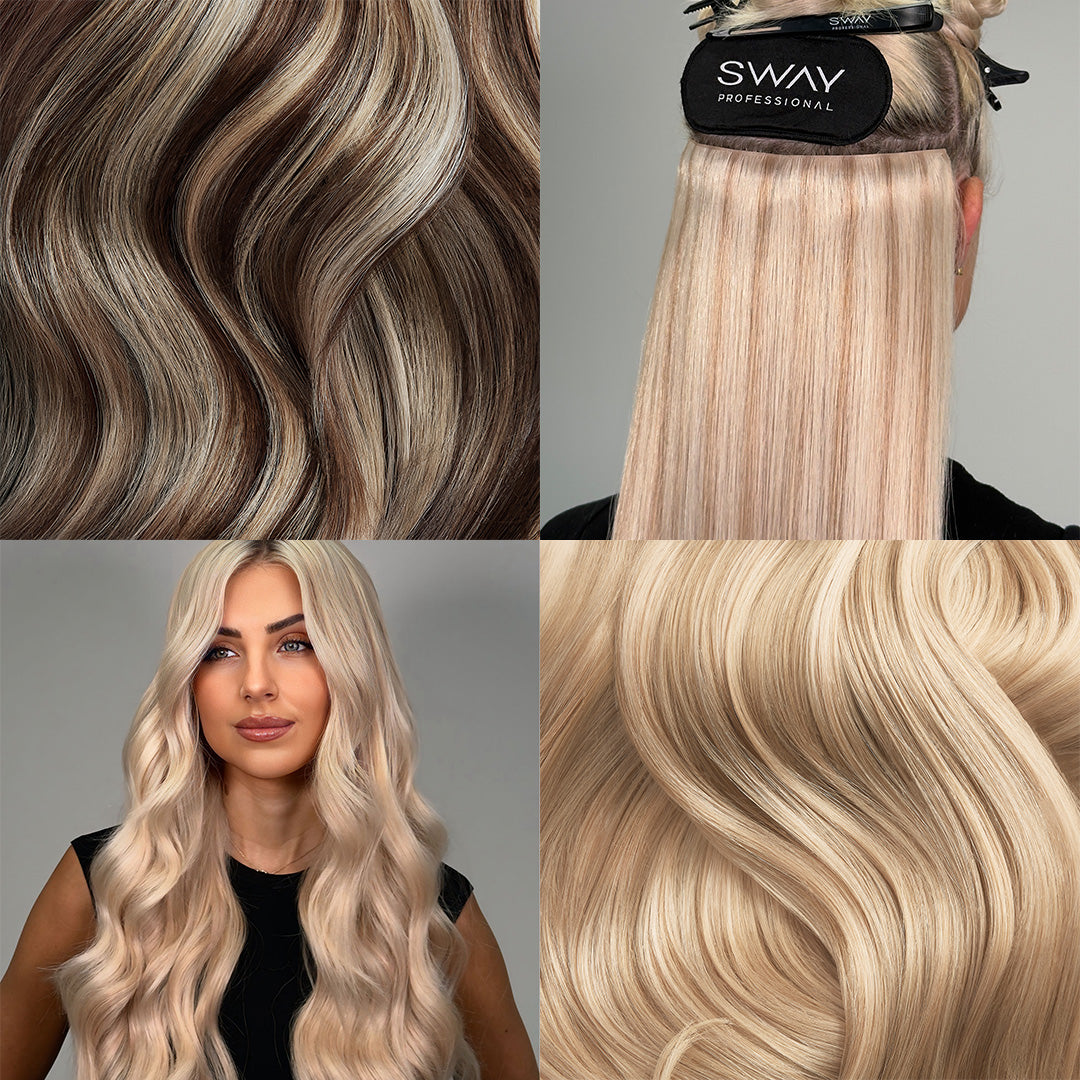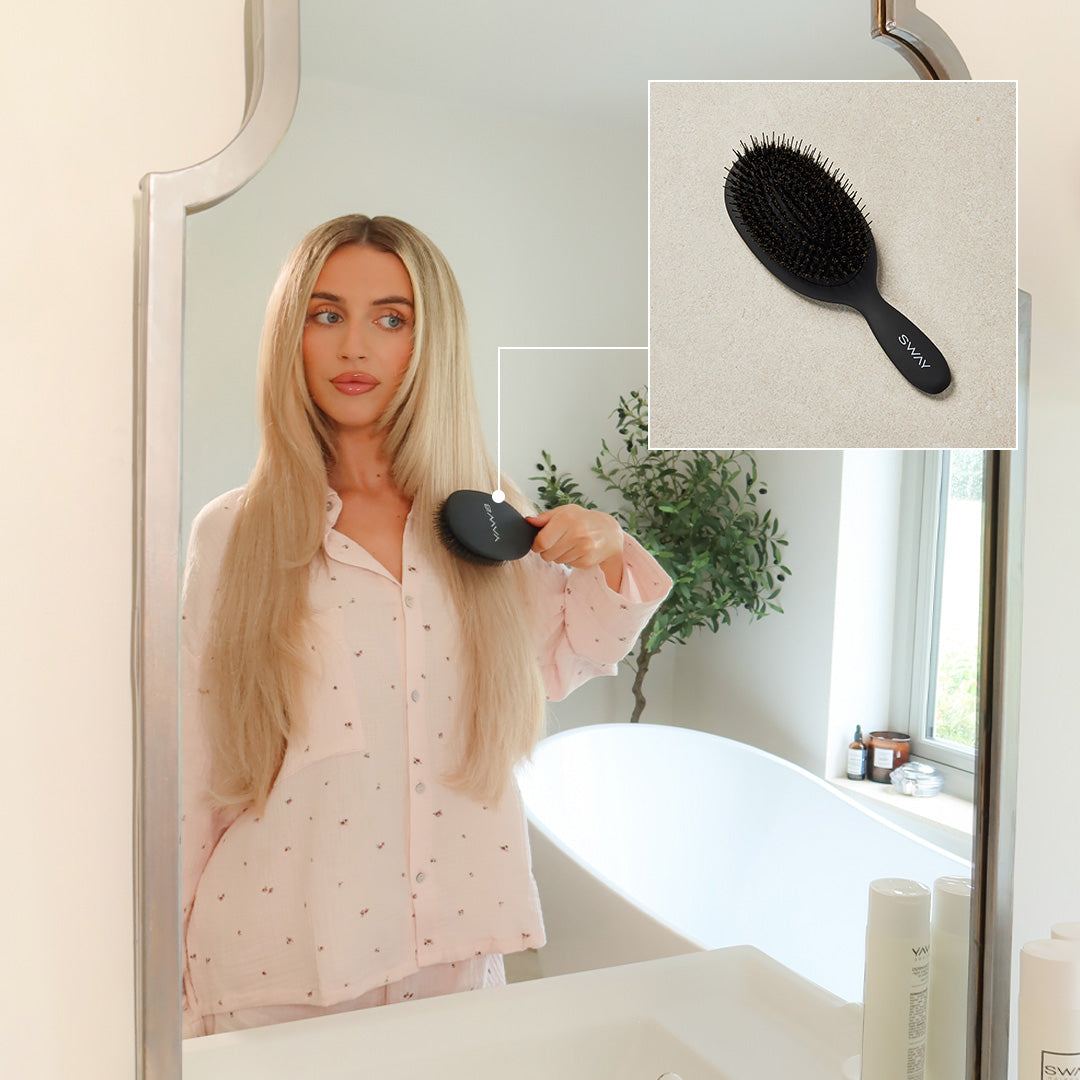Hair extensions have gained tremendous popularity since they deliver quick results by adding length, volume and colour to your natural hair. The variety of hair extensions available makes it essential to carefully select the appropriate type that matches your individual hair type.
Our article provides a comparison of two widely-used hair extension options: nano and micro extensions. We'll analyse their key differences and tell you how to properly choose the right extensions before booking an appointment with your hair stylist.
Nano vs Micro Hair Extensions: Truly Defined
What Are Nano Hair Extensions?
Nano extensions are among the smallest options available in the market today. They’re fitted strand by strand using silicone Nano bonds, making them a brilliant match for women with fine or lighter hair.
Because the bonds are so tiny, they lie flat against your scalp, blending effortlessly with your own hair. This is especially handy if you’re blonde or have thinner strands where bigger bonds might otherwise peek through. Once fitted, they move naturally and are virtually impossible to spot, even if someone runs their fingers through your hair.
Another bonus? SWAY Nano extensions are completely free from heat or chemicals, meaning they’re gentle on your natural hair. They can be applied and removed with ease, leaving no sticky residue behind, which is a win all around!
What Are Micro Hair Extensions?
Micro extensions, also known as Micro rings or Micro beads, use a similar fitting technique. The nature of these bonds makes them perfect for women with denser or textured hair because they can be hidden within the thicker strands.
The extensions provide excellent stability, durability, and deliver superior grip. This makes them perfect for women who want to increase their hair volume and length.
They share Nano characteristics because they don't need heat, allowing your natural hair to stay healthy. At SWAY, our pre-loaded silicone Micro beads are available in a variety of shades for those who are looking for a natural finish.
Nano vs Micro Hair Extensions: Key Differences
Size of the Beads
One of the most noticeable differences between nano and micro hair extensions is the size of the beads used to attach the extensions to your natural hair. This difference directly impacts how visible the extensions are once applied and how well they blend, especially if you have finer hair.
Nano Beads
-
Diameter: Roughly 2–3 mm in size.
-
Visibility: Extremely small, nearly invisible even in very fine or thin hair.
-
Nano bonds are the smallest available on the market, making them a great choice if you want a natural look. Because they sit very close to the scalp and are small, they are hard to see, even when your hair is tied up or styled.
Micro Beads
-
Diameter: Typically 4–5 mm in size
-
Visibility: Slightly more noticeable than nano beads, especially if you have fine or light-coloured hair.
-
Micro rings are larger and better if you have medium to thick hair. They require more natural hair to support the bead and extension. While still fairly small, they may be visible if placed too close to the hairline or parting, especially if you have thinner hair.
Application Technique
Both nano and micro hair extensions use a strand-by-strand technique that involves threading your natural hair through tiny beads. It uses tools like a loop tool, pulling needle, and sectioning clips for accurate parting. It also uses hair extension pliers to hold the beads in place.
Nano extensions use ultra-small beads that take more time and precision to apply with an average application time of 2 to 4 hours for a full head. Its tiny bead size makes the installation process more detailed and requires the expertise of an experienced stylist.
Micro extensions utilise bigger beads that make handling easier. Installing micro extensions can take between 2 to 3.5 hours and is easier to perform.
Comfort & Weight
Nano and micro hair extensions prioritise lightweight and gentle comfort when applying to the scalp. If you have fine hair or a sensitive scalp, you may find nano hair extensions to be more comfortable.
Their small size and light weight beads mean they apply minimal tension to your natural hair. Their lightweight properties make them a great option if you're new to wearing extensions or if you aren't comfortable with heavier alternatives.
Micro hair extensions are a comfortable option for many people, but utilise bigger beads. This can lead to a slight bulkiness on the scalp that becomes especially noticeable during the initial days following installation.
Each section of natural hair experiences extra stress when multiple extensions are added or if the natural hair is thin. People who have medium to thick hair types generally handle the extra weight of micro hair extensions well. However, if you have finer hair you could experience significant tension or gentle pulling.
Suitability for Hair Types
Nano hair extensions are best suited for fine to medium hair. Their ultra-small beads are small and lightweight, meaning they blend effortlessly into finer strands without adding bulk or causing noticeable strain on your scalp. If you have thin or fragile hair, nano extensions will give you a comfortable and natural-looking solution without risking damage or visibility.
Micro hair extensions, on the other hand, are more appropriate if you have medium to thick hair. The slightly larger beads require more natural hair to grip, which can put too much tension on finer strands. However, they work very well with denser hair, offering durability and volume without being overly noticeable.
Maintenance & Longevity
Nano and micro hair extensions are semi-permanent and need regular maintenance to maintain their appearance. The growth of natural hair makes beads move away from the scalp, which requires repositioning every 6 to 8 weeks for both nano and micro extension methods. To make sure it looks natural and comfortable, your extensions must be detached then reapplied closer to the roots.
Nano hair extensions need additional care to maintain because they are smaller than micro extensions. When applied to fine hair, it is crucial to prevent pulling and applying thick products around the bonds.
Micro extensions are more durable because of their larger beads, but require proper maintenance. This includes using gentle brushing, using sulfate-free shampoos , and avoiding conditioner at your roots to prevent the beads from slipping
Both nano and micro extensions can last six months or longer when properly maintained and may often be reused at appointments. Salon upkeep and gentle treatment routines will help you maintain the freshness and health of both hair extension methods.
How to Choose:Nano vs Micro Hair Extensions
You should evaluate multiple factors before deciding between nano and micro hair extensions to choose the best option for your personal needs. Hair type is a crucial factor when selecting hair extensions. If you have fine or thin hair, you will find nano extensions preferable because their miniature beads remain hidden and prevent unwanted bulk.
Nano extensions blend smoothly into hair while exerting minimal stress on the scalp to protect delicate strands. If you have medium to thick hair, you should choose micro extensions because their larger beads help create a better hold and increased volume.
Another key consideration is your lifestyle. Nano extensions are great if you want to make minimal salon visits because they blend well and require infrequent adjustments. Micro extensions are a good solution for quick application if you're willing to maintain them every 6 to 8 weeks.
Nano vs Micro Hair Extensions: FAQs
1. What’s the main difference between nano and micro hair extensions?
The main difference is the size of the beads. Nano beads are much smaller, about 2–3 mm, while microbeads are larger, around 4–5 mm. Nano extensions are smaller and better for finer hair, whereas micro extensions work well for medium to thick hair types.
2. Which is better for fine hair, nano or micro extensions?
Nano extensions are typically better for fine hair due to their smaller beads. They are less likely to cause tension or add bulk, making them more comfortable for delicate strands. Micro extensions, on the other hand, might be slightly more visible and could put extra strain on finer hair.
3. How long do nano and micro extensions last?
Both nano and micro extensions can last up to 6 months with proper care. However, the beads will need to be repositioned every 6 to 8 weeks as your natural hair grows. The extensions themselves can often be reused during maintenance appointments if they’re in good condition.
4. Do nano or micro extensions damage your natural hair?
When installed and maintained properly, both methods are safe to apply to natural hair. Hair damage results from improper installation methods, excessive tension, or a lack of regular maintenance.
5. Which extensions are more comfortable to wear?
The reduced tension and flatter positioning of smaller beads makes nano extensions feel more comfortable on the scalp. Micro extensions tend to appear bulkier during the first several days following application, yet are comfortable for the majority of users.




 Powered by
Powered by  – finance available up to 24 months
– finance available up to 24 months